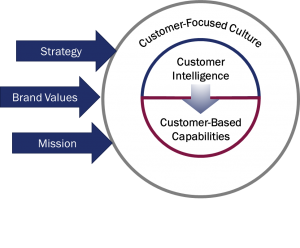 Great companies base their capabilities off of the knowledge of their customer-facing staff. While they use market research and strategic planning, companies with a consistently great customer experience get that way by creating deliberate processes to learn from their employees.
Great companies base their capabilities off of the knowledge of their customer-facing staff. While they use market research and strategic planning, companies with a consistently great customer experience get that way by creating deliberate processes to learn from their employees.
Leveraging Your Customer-Facing Staff to create Employee-Based Innovation is the last piece of the Customer-Based Capabilities section of the Heart of the Customer model. Citrix, Oracle and Safelite all referenced practices to gather insights from their employees, but Fidelity again provides the best guidance.
This is the fifth post in the Real-World series where I use Heart of the Customer’s Customer Experience model to show how the 2012 Temkin Customer Experience Award finalists actually go about building their customer experiences. Previous posts showed how finalists:
Citrix
Citrix uses customer forums to gather external feedback, receiving ideas on product improvements and letting their customers vote on the list. They have a similar forum for all employees to submit and vote for ideas to improve the customer experience. Product Managers keep employees informed on where ideas are in the development process.
Oracle
Oracle didn’t go much into gathering employee ideas, but they did share that they have an internal website named MyIdeas@Work that sounds like Citrix’s.
Safelite
Safelite’s “People Pledge” includes “You’ll often be asked for your opinions and involved in decisions that affect your work.” Unfortunately, they did not give much detail behind how they implement this pledge.
Fidelity
Fidelity went into great detail on how they involve their staff. They deliberately engage customer-facing associates through listening posts such as Spaces, which connects front-line associates with corporate staff to focus on how to improve the overall customer experience. They also create roadshows, webcasts, discussion boards and crowd-sourcing platforms to collect ideas to improve their customer experience.
Spaces is a discussion board that allows front-line and headquarters staff to talk back and forth on ideas to improve customer experiences. Spaces features thousands of discussion threads dedicated to customer experience improvements, with product, segment, channel and functional leaders all actively engaged in this online community to solicit the Ambassadors’ insights and also close the loop on solutions implemented.
As the company reports, “Field associates are encouraged to candidly share experience issues that are plaguing our customers. In addition, during field CX road shows, associates depicted top CX issues in a ‘rock’ poster contest (“rocks” are customer pain points) that generated hundreds of new opportunities for improvement.”
My Take
While it may not seem that way, consistently collecting employee feedback and acting upon it is really hard. That’s why so few companies are really good at consistently doing this.
While employees have your very best ideas on how to better serve your customers, they can also have some of the worst. It takes a deliberate effort to separate these and build on the best. But doing so creates success on two fronts: it helps you better serve your customers, but it also builds employee engagement. It’s a shame these companies didn’t give more detail, as that’s absolutely critical to success.



